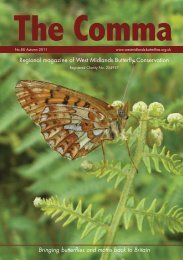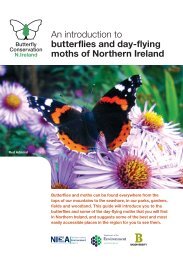EIG newsletter - Butterfly Conservation
EIG newsletter - Butterfly Conservation
EIG newsletter - Butterfly Conservation
Create successful ePaper yourself
Turn your PDF publications into a flip-book with our unique Google optimized e-Paper software.
Eastern Brown Argus (Kretania<br />
euripylus<br />
Photo: Tristan Lafranchis<br />
The Rare Lycaenids of the Peloponnese<br />
The Peloponnese, the large peninsula of southern Greece is<br />
actually an island as the Corinth canal, joining the Ionian Sea<br />
to the Gulf of Corinth, separates it from the rest of Greece. It<br />
has a high diversity for butterflies and along with the Alps and<br />
the Pyrenees was identified by Kudrna (2002) 1 as one of the<br />
areas of Europe with the highest species diversity. For<br />
example no less than 109 species of butterflies have been<br />
recorded above 1500 m on Mount Chelmos and sites with<br />
more than 80 species are found in many areas in the<br />
Peloponnese, both in low valleys and high up in the mountains. It is particularly<br />
notable for its Lycaenids (33 or 34 species) and though with the exception of the<br />
Taygetos Blue (Polyommatus menelaos), these are not endemic being found usually<br />
further east in Turkey; several species have their European range mostly confined to<br />
the Peloponnese. These include the Chelmos Blue<br />
(Agrodiaetus iphigenia), the Pontic Blue (Neolysandra<br />
coelestina) which is also found in Attica, the Fiery Copper<br />
(Lycaena thetis) and the Odd Spot Blue (Turanana endymion).<br />
The Greek Mazarine Blue (Cyaniris semiargus helena), which<br />
has bright orange submarginal lunules on both sides of the<br />
hind wing is a Peloponnese endemic if it is, as some<br />
authorities suggest, a separate species. The Eastern Brown<br />
Argus (Kretania eurypilus) another Asiatic species is also<br />
found in its most westerly site on Mount Taygetos in the south<br />
of the Peloponnese, but also occurs on Samos.<br />
At high altitude on the mountains of Mount Chelmos and Mount Taygetos there is an<br />
unusual habitat of Acantholimon androsaceum which grows<br />
in dwarf cushions amongst the rocks. Its habit allows it to<br />
withstand extreme desiccation and high winds as well as<br />
browsing goats. This is the larval food-plant of both Fiery<br />
Copper and Odd Spot Blue, which occur together in the few<br />
hectares of this habitat found on those mountains. Fiery<br />
Odd-spot Blue (Turanana endymion)<br />
Photo: Simon Spencer<br />
Copper also occurs on Mount Parnassos and elsewhere<br />
on the other side of the Gulf of Corinth in the small areas of<br />
Acantholimon found on the mountains. These species are two of the few European<br />
species vulnerable to collectors as neither the sites nor the species have any real<br />
protection and are regularly visited. Mount Chelmos is a Natura 2000 site (GR<br />
2320002) but in Greece as in other countries this does not stop collecting if the<br />
species are not protected by law. Neither are Red Data Book 2 species due to their<br />
distribution in Turkey and elsewhere. The local and scarce Bavius Blue<br />
(Pseudophilotes bavius), a red data book species, found also in Turkey, Macedonia<br />
and elsewhere is another favourite target of collectors visiting<br />
the Peloponnese. It is known from two areas, on the foothills<br />
of Mount Menalon and Mount Chelmos. In the Chelmos site,<br />
two visits during the flight period in May 2006 to look for it<br />
proved unsuccessful and neither butterflies nor eggs could be<br />
found. Apparently a German collector frequently stayed there<br />
in the previous years to collect all the butterflies and eggs he<br />
could find.<br />
1 Kudrna, O. Distribution of European Butterflies, Oedippus 20, 2002<br />
2 van Swaay, C. & Warren, M.S. (1999). Red Data Book of European butterflies (Rhopalocers). Council of Europe, Strasbourg<br />
(Nature and Environment Series No. 99)<br />
10<br />
Greek Mazarine Blue (Cyaniris<br />
semiargus helena)<br />
Photo: Simon Spencer<br />
Fiery Copper (Lycaena thetis)<br />
Photo: Tristan Lafranchis







